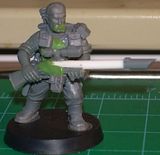
So for the current FtW round table discussion Ron posed the question
"You have just been put in charge of Warhammer 40k for GW.
They would like to know what you think the company should do with the start of the new year.
What are the Top 3 things you would change about Warhammer 40k?"
Which started me thinking - what would i want to change in the 40K world. Originally when i looked at the question, my first reaction was to change some of the rules - to bring back some things that i think are missing (overwatch!) and to remove some things that i think make games unbalanced ("And they shall know no fear").
But then i started to realise that in many ways, the current 5th edition of 40K is actually quite a decent game. Sure it doesnt have all the intricacies of "Rogue trader" nor the totally silly weapons of the second edition, but it is fast and fun to play, and for the most part the designers have do a good job of clarifying and cleaning up the rules.
So having moved on from the game in general, i started to think about everything that surrounds gaming, and how i would improve that... Here are the answers that i came up with -
1. Setup an online community forum with experimental rules and interaction with gamers before, during and after release of main rules and codex include better online errata rules for each army, including a points calculator / unit development tools for creating your own custom units at home.
I have always had a bit of a problem with the fact that GW puts out rulebooks full of errors, and then takes ages to put up any erratta for them. When the errata does come out, it tends to be a very brief overview and doesnt answer some of the more detailed problems.
There doesnt seem to be any proper interaction between the GW designers and the people who play the games (namely us!). What i would like them to do is to setup a web forum, which the designers frequent and on which you could ask questions, get definitive answers, as well as helping to play test new rules that are coming up - For example, so of the changes to the vehicle rules between 4th and 5th editions could have been trialled in this way.
I would also really like to see the designer be more open about the way that they develop the points cost for the units they design, and if possible to make available the calculation tools that they use (I have this theory that its just an Excel file that they input some numbers to and it gives them a points cost - similar to what they have for Battletech etc).
With this sort of tool it would be trivial to create custom units that were "somewhat" official (in the sense that the points were at least in the right range...).
2. Provide software tools for army building that are included with a copy of the codex, which run completely cross platform (Mac OS, Linux, Windows)
Okay so I will freely admit that I am a nerd (and judging by the fact that most people reading this are also bloggers, gamers and painters I would guess the same applies to many of you!) and that this one is a nerdy request, but why is it, in this day and age that 40K codexes (codicies?) dont come with a set of database files for a well designed piece of software that allows you to build and setup your army? I know there was the poor thing that GW put out a year or so ago (and promptly forgot about) and I know that there is "Army Builder", but both of these applications are Windows only. Let me say this loud and clear
THERE ARE PEOPLE WHO DONT USE WINDOWS!
Ahem...
In an ideal world, i would really like this to be included with each codex, along with templates for basic armies, images of painted models for that army and a PDF copy of the codex - (maybe on a locked memory stick for copy protection purposes?). Okay, it might add a small amount to the cost of the codex - which lets face it are not exactly cheap at the moment, but think of all the time it would save and hastle playing round in Excel. However, i dont want it all digital - for gaming at a friends house the paper codex will always be needed.
3. Bring out plastic titans!
Yep, everyone wants a titan (or three!). So i'd put together multiple kits (Warhound, Reaver, Warlord, Gargants etc) for as many armies as possible. Then put them out as plastic kits at under £100. I'd put money on them being one of the most popular kits they make.
So there we go, my 3 ways to chnge the 40K landscape. Comments welcome as always, and thanks to Ron for such an interesting round table idea!






































